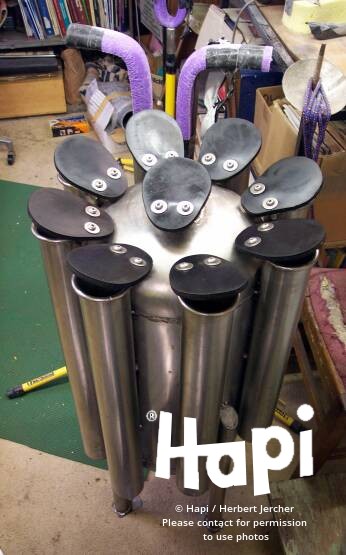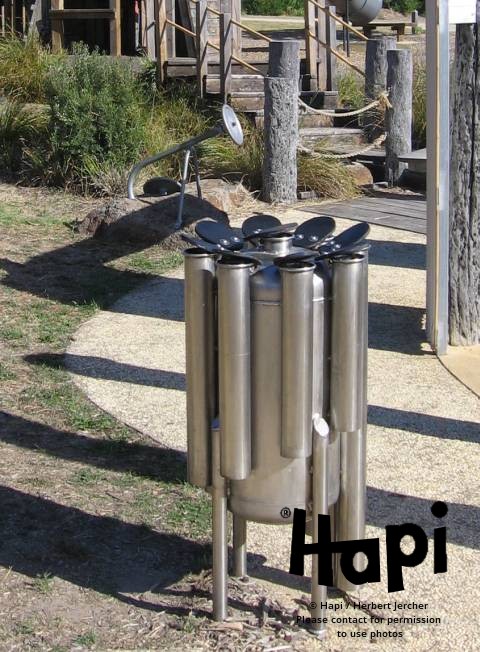 A HAPI® contradiction
A HAPI® contradiction
by Andrew Goode
Sound sculptor Herbert Jercher has been building outdoor sound sculptures and
playground instruments for more than 20 years. His work can be found in public
parks and school playgrounds right across Australia. These durable instruments
are now built under the name Herb's Acoustic Playground Instruments (HAPI®).
These are not production-line models, each is a handcrafted original signed by
the artist, and often designed especially for a site. To suit their outdoor
locations, they are made to be virtually indestructible, yet produce a tone
that is clearly (and first of all) musical. This makes a welcome change from
"playground instruments" that lack proper tuning, or are mass produced as
coarse noisemakers.
Designing any kind of amenity for a public space - let alone a musical
instrument - can't be that easy. First of all, there are extremes of weather,
and then vandal-proofing to consider. Add to this the many public safety
considerations - and even local noise laws - and you begin to appreciate what
it means to put a musical instrument out in the open for a community to enjoy.
All these things become evident when I visit Herb at his Sunshine workshop, and
he takes me to his latest: a stainless steel tapper instrument that looks from
a distance like a rocket ship out of a 1920s sci-fi movie. It's squat, silver
body stands on four legs, and is ringed by thinner tubes of different lengths
that could easily be some kind of booster rockets. I imagine it ready for a
"Journey to the Moon", and pretty soon too.
"It's called a tadpole tapper," Herb tells me as we get closer.
A what?
"The client asked for something that sounded like a frog for their site theme
and well, this one sort of sounds like a frog. Why don't you try to play it."
Then I notice the leather tappers over the tubes, a ring of tadpole faces
smiling up at me! I begin to tap them with my hands like a bongo drum. Randomly
at first, and with some force, then instinctively softer as the tapping starts
to sound a musical scale, and then a melody.
"You can play a theme from Bartok's
Concerto for Orchestra
on it," I say after a while.
Herb nods. "That's because of the tritone in the scale."
Then he takes over and plays, using only his index fingers and thumbs, a
pattern of notes in shifting harmonies, a texture of interlocking arpeggios.
Occasionally the deep resonant sound of the instrument's body recalls an Indian
tabla drum. I feel privileged to witness this short, private performance.
Then slowly it dawns on me, what I now call a HAPI® contradiction. It's that
the instrument, which is designed for a public place, creates instead a private
space, and it does this by the nature and the quality of its sound. A private
space to play, here within a public place.
It's a contradiction too, because it goes against what seems intuitive about
musical instruments generally (and sound playgrounds in particular) - namely
that the experience of the sound should also be public. There are other points
of view of course, especially when you ask the neighboursI And so through a
simple but careful design feature built right into the instrument, the needs of
a civic space can be reconciled with the needs of a genuinely musical
experience.
HAPI® instruments don't openly announce their design features in these many
respects. They are made from industrial materials and have the life expectancy
of other outdoor playground equipment. Not bad for a musical instrument, which
must also retain a quality that can only be appreciated from the experience.
After all, the proof of the instrument is in the listening.
In the end Herb had convinced me on that other point too. In a strange sort of
way, if you really, really listened, it did sound something like a frog...
A field full of them in fact.

The tadpole tapper in the studio workshop

The tadpole tapper on site